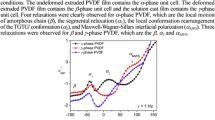Abstract
Dielectric relaxation behavior of poly(vinylidene fluoride–hexafluoropropylene) [P(VDF–HFP)] is investigated on the basis of dielectric relaxation spectroscopy at 20–200 °C and 20–5 MHz after conversion to complex electric modulus formalism. It is found that imaginary modulus spectra exhibit asymmetry peak with peak-width much broader than that of the Debye peak. The peaks are skewed toward the high frequency sides due to the effect of the conductivity. The complex electric modulus data have been fitted using non-exponent Kohlrausch–Williams–Watts and Cole–Cole functions. The results show that the non-exponent parameter (β) and the shape parameter (α) are all lower than idealized Debye-type, indicating a wide relaxation distribution of P(VDF–HFP). Both the activation energies Ea from \({\text{M}}^{\prime \prime }\) spectra and conductivity are all due to the contribution of dc and ac conductive relaxation process.







Similar content being viewed by others
References
N. Murayama, K. Nakamura, H. Obara, M. Segawa, The strong piezoelectricity in polyvinylidenefluroide (PVDF). Ultrasonics 14, 15–23 (1976)
J.Y. Song, C.L. Cheng, Y.Y. Wang, C.C. Wan, Microstructure of poly(vinylidene fluoride)-based polymer electrolyte and its effect on transport properties. J. Electrochem. Soc. 149, A1230–A1236 (2002)
M.D. Micahed, N.A. Bakr, M.I. Abdel-Hamid, O. El-Hanafy, M. El-Nimr, Dielectric relaxation and electric modulus behavior in poly(viny1 alcohol)-based composite systems. J. Appl. Polym. Sci. 59, 655–662 (1996)
W. Howard, J.R. Starkweather, P. Avakian, Conductivity and the electric modulus in polymers. J. Polym. Sci. Polym. Phys. 30, 637–641 (1992)
N.G. McCrum, B.E. Read, G. Williams, Anelastic and Dielectric Effects in Polymeric Solids (Wiley, NewYork, 1967), pp. 108–111
P.B. Macedo, C.T. Moynihan, R. Bose, The role of ionic diffusion in polarization in vitreous ionic conductors. Phys. Chem. Glasses 13, 171–179 (1972)
F.Q. Tian, Y. Ohki, Electric modulus powerful tool for analyzing dielectric behavior. IEEE Trans. Dielectr. Electr. Insul. 21, 929–931 (2014)
A.C. Lopes, C.M. Costa, R.S. i Serra, I.C. Neves, J.G. Ribelles, S. Lanceros-Méndez, Dielectric relaxation, ac conductivity and electric modulus in poly(vinylidenefluoride)/NaY zeolite composites. Solid State Ion. 235, 42–50 (2013)
A. Karmakar, A. Ghosh, Dielectric permittivity and electric modulus of poly-ethylene oxide (PEO)–LiClO4 composite electrolytes. Curr. Appl. Phys. 12, 539–543 (2012)
S.A. Chen, C.S. Liao, Conductivity relaxation and chain motions in conjugated conducting polymers: neutral poly(3-alkylthiophene)s. Macromolecules 26, 2810–2816 (1993)
A.K. Jonscher, Dielectric relaxation in solids (Chelsea Dielectric press, London, 1983)
G.M. Tsangaris, G.C. Psarras, N. Kouloumbi, Electric modulus and interfacial polarization in composite polymeric systems. J. Mater. Sci. 33, 2027–2037 (1998)
S.R. Eliotta, Ac conduction in amorphous chalcogenide and pnictide semiconductors. Adv. Phys. 36, 135–218 (1987)
I.M. Hodge, M.D. Ingram, A.R. West, Impedance and modulus spectroscopy of polycrystalline solid electrolytes. J. Electroanal. Chem. 74, 125–143 (1976)
A.A. Saif, P. Poopalan, AC conductivity and dielectric relaxation behavior of sol–gel BaxSr1−xTiO3thin films. J. Mater. Sci. Technol. 27, 802–808 (2011)
K.L. Ngai, S.W. Martin, Correlation between the activation enthalpy and Kohlrausch exponent for ionic conductivity in oxide glasses. Phys. Rev. B 40, 10550–10556 (1989)
P.K. Dixon, Specific-heat spectroscopy and dielectric susceptibility measurements of salol at the glass transition. Phys. Rev. B 42, 8179–8186 (1990)
R.M. Neagu, E. Neagu, N. Bonanos, P. Pissis, Electrical conductivity studies in nylon 11. J. Appl. Phys. 88, 6669–6677 (2000)
M. Mudarra, J. Belana, J.C. Canadas, J.A. Diego, J. Sellares, Space charge relaxation in polyetherimides by the electric modulus formalism. J. Appl. Phys. 88, 4807–4812 (2000)
D.R. Day, T.J. Lewis, H.L. Lee, S.D. Senturia, The role of boundary layer capacitance at blocking electrodes in the interpretation of dielectric cure data in adhesives. J. Adhes. 18, 73–90 (1985)
J.R. Macdonald, Impedance Spectroscopy (Wiley, New York, 1987)
G. Perrier, A. Bergeret, Maxwell–Wagner–Sillars relaxations in polystyrene–glass-bead composites. J. Appl. Phys. 77, 2651–2658 (1995)
V. Baziard, S. Breton, S. Toutain, A. Gourdenne, Dielectric properties of aluminium powder-epoxy resin composites. Eur. Polym. J. 24, 521–526 (1988)
V. Baziard, S. Breton, S. Toutain, A. Gourdenne, Dielectric properties of copper powder-epoxy resin composites. Eur. Polym. J. 24, 633–638 (1988)
V.V. Kochervinskii, I.A. Malyshkina, G.V. Markin, N.D. Gavrilova, N.P. Bessonova, Dielectric relaxation in vinylidene fluoride–hexafluoropropylene co-polymers. J. Appl. Polym. Sci. 105, 1101–1117 (2007)
M.D. Migahed, F. Fahmy, Structural relaxation around the glass transition temperature in amorphous polymer blends: temperature and composition dependence. Polymer 35, 1688–1693 (1994)
A.S. Nowich, B.S. Lim, A.V. Vaysleyb, Nature of the ac conductivity of ionically conducting crystals and glasses. J. Non-Cryst. Solids 172–174, 1243–1251 (1994)
Acknowledgments
This work was funded by National Basic Research Program of China (“973” Program No. 2010CB71600) and Natural Science Foundations of Hebei province of China (E2012203153).
Author information
Authors and Affiliations
Corresponding authors
Rights and permissions
About this article
Cite this article
Zhao, X., Peng, G., Jiang, X. et al. Investigation of relaxation process in poly(vinylidene fluoride–hexafluoropropylene) using dielectric relaxation spectroscopy. J Mater Sci: Mater Electron 27, 718–723 (2016). https://doi.org/10.1007/s10854-015-3808-3
Received:
Accepted:
Published:
Issue Date:
DOI: https://doi.org/10.1007/s10854-015-3808-3




